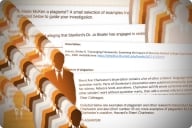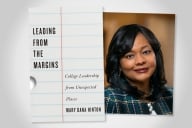You have /5 articles left.
Sign up for a free account or log in.
Spinach is not an exceptional nutritional source of iron. The leafy green has iron, yes, but not much more than you’d find in other green vegetables. And the plant contains oxalic acid, which inhibits iron absorption.
Why, then, do so many people believe spinach boasts such high iron levels? Scholars committed to unmasking spinach’s myths have long offered a story of academic sloppiness. German chemists in the 1930s misplaced a decimal point, the story goes. They thus overestimated the plant’s iron content tenfold.
But this story, it turns out, is apocryphal. It’s another myth, perpetuated by academic sloppiness of another kind. The German scientists never existed. Nor did the decimal point error occur. At least, we have no evidence of either. Because, you see, although academics often see themselves as debunkers, in skewering one myth they may fall victim to another.
In his article “Academic Urban Legends,” Ole Bjorn Rekdal, an associate professor of health and social sciences at Bergen University College in Norway, narrates the story of these twinned myths. His piece, published in the journal Social Studies of Science, argues that through chains of sloppy citations, "academic urban legends" are born. Following a line of lazily or fraudulently employed references, Rekdal shows how rumor can become acknowledged scientific truth, and how falsehood can become common knowledge.
A Tale of Two Myths
The claim that spinach is a rich source of iron is not an academic urban legend in the same way the decimal point error story is. Scholars disproved the iron myth long ago, although it remains widely believed. The decimal point story, however, stood until Mike Sutton, a criminologist at Nottingham Trent University, debunked it in 2010. In addition to showing that the story lacked documentation, Sutton argued that other factors, such as researchers documenting the iron levels of dried spinach instead of fresh spinach, caused the belief that spinach was a tremendous iron source.
Even so, when Rekdal came across a 1995 article by K. Sune Larsson in the Journal of Internal Medicine that said the iron myth came from a decimal point error in the 1930s, he paused. He hadn’t known that spinach wasn’t a good source of iron. And the decimal point story struck him as a powerful reminder of the importance of accuracy and quality control in research.
How would he pass on this newfound knowledge? In reflecting on this question, Rekdal identifies four ways academics cut corners when citing sources.
A scholar might omit a reference entirely, presuming that a piece of information – such as the “fact” of researchers misplacing a decimal point – is common knowledge. Or a scholar might cite a secondary source without acknowledging or consulting the primary source. For example, Rekdal might cite Larsson without mentioning that Larsson was citing a 1981 article by another researcher, Terence Hamblin.
A third way would be to refer to Hamblin and add “cited in Larsson.” And a fourth alternative would be to cite Hamblin only – but without consulting his article.
All these shortcuts “share attributes with various ways in which rumors are spread,” Rekdal writes.
The fourth alternative is risky because you’re trusting that the secondary source has interpreted the primary source correctly. And Larsson, Rekdal writes, has not gotten Hamblin right. Hamblin’s original text dates the (apocryphal) decimal point error to the 1890s, not the 1930s, as Larsson reported. (Yet another source, a medical textbook from 1982, dates the supposed decimal point error to 1870.) And as for Hamblin’s evidence to support his claim about the decimal point error? He offers no reference. It was merely something he’d heard or read, possibly from an earlier researcher who, in the same vein, offered no documentation for the claim.
Yet the decimal point story made its way into countless journals, medical texts and books. Through a failure on the part of many scholars to fact check or consult primary sources, a rumor bore the stamp of academic credibility for decades.
Combating Academic Falsehoods
An academic urban legend such as the decimal point myth -- “where a huge herd of academics are following each other blindly for 30 years, jointly disregarding the most basic principles for handling of knowledge” – is rare, Rekdal said in an interview. Yet the poor citation practices his article describes – such as depending on unreliable sources, failing to consult primary sources, or twisting a source’s meaning to make it better fit your argument – are common.
“The worst, in my opinion, is citation plagiarism: referring to a primary source you have copied from a secondary one, without consulting the former,” Rekdal said. “You then turn one single observation, interpretation or misinterpretation into two apparently independent ones, mutually reinforcing each other in a way that is entirely undeserved.”
Citation plagiarism is almost impossible to detect until patterns of errors – multiple scholars employing the same faulty interpretation, allegedly gleaned from a primary source – emerge in a series of published works, he noted.
Poor citation practices prevail across disciplines, Rekdal said. He’s noticed that historians, however, tend to cite conscientiously.
Philosophers, by contrast, may be the worst of the lot, one philosopher and journal editor said. “This is part and parcel of the attitude of most philosophers these days,” said J. Angelo Corlett, a philosophy professor at San Diego State University and the editor of The Journal of Ethics. “That scholarship matters nothing. That what really matters is the cleverness of your ideas and how you articulate them.”
Rekdal blames corner-cutting on publication pressures. Authors are tempted to take shortcuts, and reviewers and editors don’t have time to do their jobs properly. Corlett, however, chalked up sloppy referencing not to the publish-or-perish standard but to a lack of proper guidance for graduate students.
“Mentors are doing a horrible job teaching their mentees how to do scholarship well,” he said. “That’s the main issue.”
The ethicist said academics should treat careful scholarship as a moral requirement. “Don’t place your readers in the unfortunate or uncomfortable position of having to trust more than they already have to,” Corlett said. “That’s a matter of ethics.”
In an equally entertaining article published online in May, Rekdal wrote about a "puzzling phenomenon" in academe: that few authors, editors and publishers care about the relevance or accuracy of references. "At times," Rekdal wrote, "I get the feeling that references have been placed in quantities and with a degree of precision reminiscent of last minute oregano flakes being sprinkled over a pizza on the way to the oven."
Debunking the Debunkers
Rekdal takes quiet delight in noting that many of the publications that purvey the decimal point myth themselves seek to address fallacies in scientific research, such as the canard about spinach’s iron content. Larsson’s article, for instance, is titled “The Dissemination of False Data Through Inadequate Citation.” Rekdal reports that Hamblin, who wrote the influential 1981 article, later recanted, acknowledging that he'd spread the decimal point myth. Larsson could not be reached for comment.
We might gain peevish pleasure from seeing these debunkers debunked. Yet it’s no surprise that professed attitudes often fail to match real-world behavior. Eric Schwitzgebel, a philosophy professor at the University of California at Riverside, memorably illustrated this tendency in his 2009 article “Do Ethicists Steal More Books?”, which concluded that, yes, ethicists steal more books from academic libraries than do other philosophers.
But the article’s memorability turned out to be a problem, Schwitzgebel said in an interview. The belief that ethicists behave worse has almost become an academic urban legend of its own.
His study of ethicists’ book-stealing habits was his first on the topic of the moral behavior of ethicists – and remains his most cited study on the topic. But his later research, conducted with Joshua Rust, an assistant professor of philosophy at Stetson University, has found that ethicists behave no morally differently than do others: no better, no worse.
“My first article on this subject is almost propagating this myth that ethicists behave worse,” Schwitzgebel said. “There’s a lot going on underneath academic memorableness. There are some things that strike us as memorable, emblematic, worth repeating … that propagate through the academic discourse. And once they’ve propagated enough they seem to be common knowledge.”
In other words, a story that sounds too good to be true might be just that.
To weed out academic urban legends, Rekdal says editors “should crack down violently on every kind of abuse of academic citations, such as ornamental but meaningless citations to the classics, or exchanges in citation clubs where the members pump up each other’s impact factors and h-indexes.”
Yet even Rekdal – who debunks the debunkers – says his citation record isn’t flawless.
“I have to admit that I published an article two decades ago where I included an academically completely meaningless reference (without page numbers of course) to a paper written by a woman I was extremely in love with,” he said. “I am still a little ashamed of what I did. But on the other hand, the author of that paper has now been my wife for more than 20 years.”








